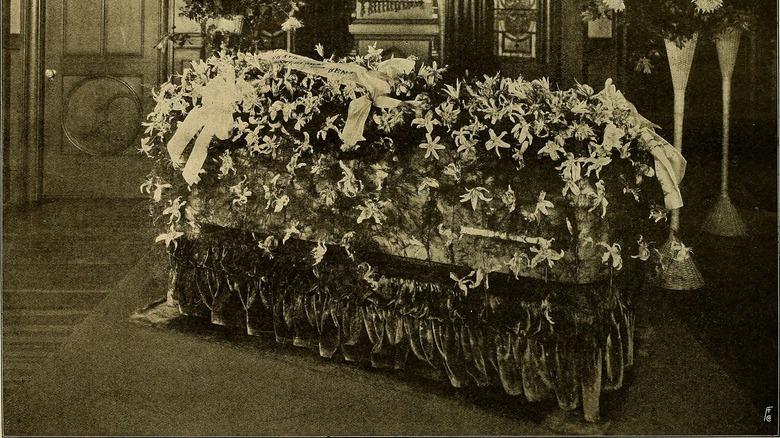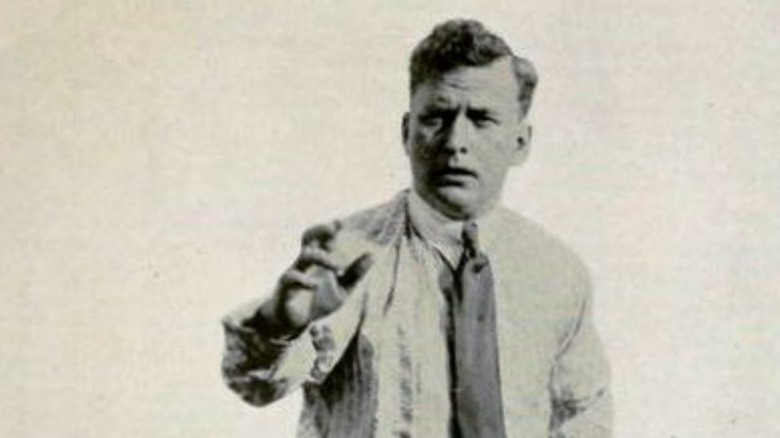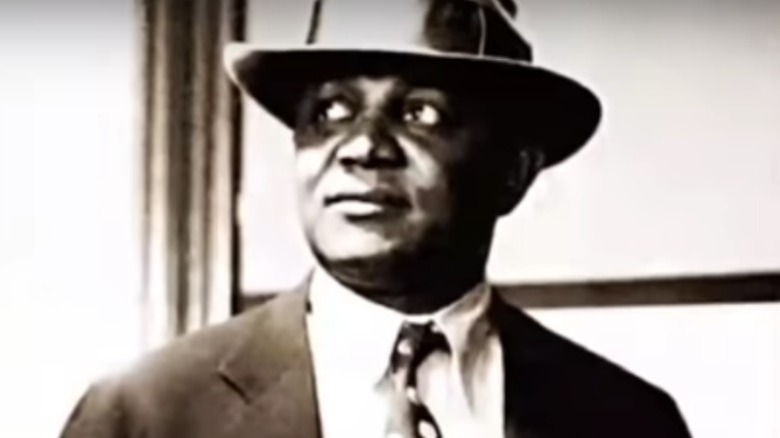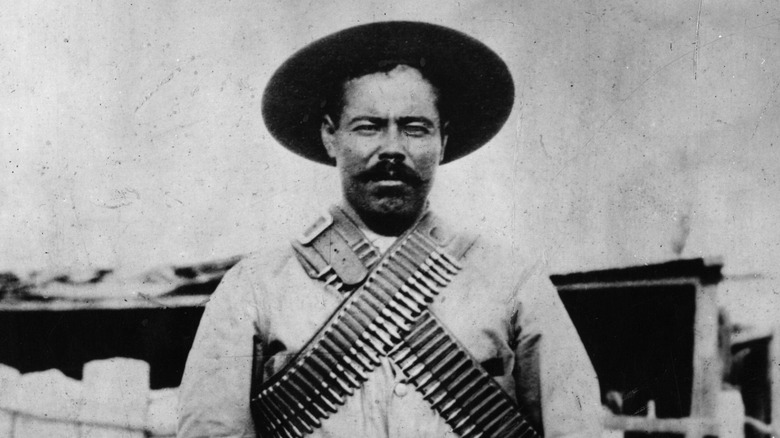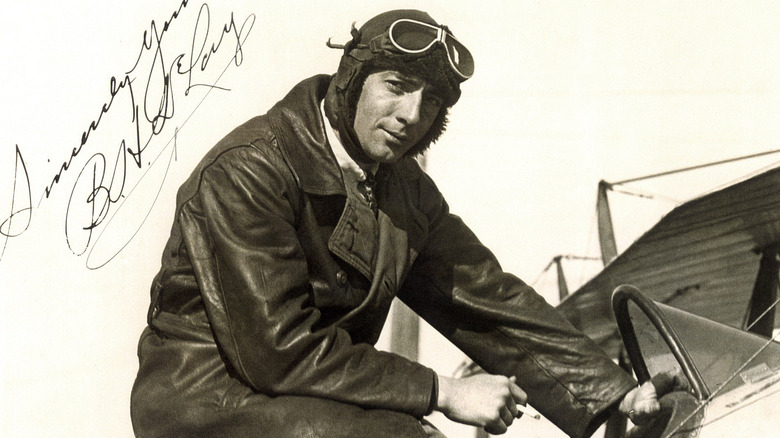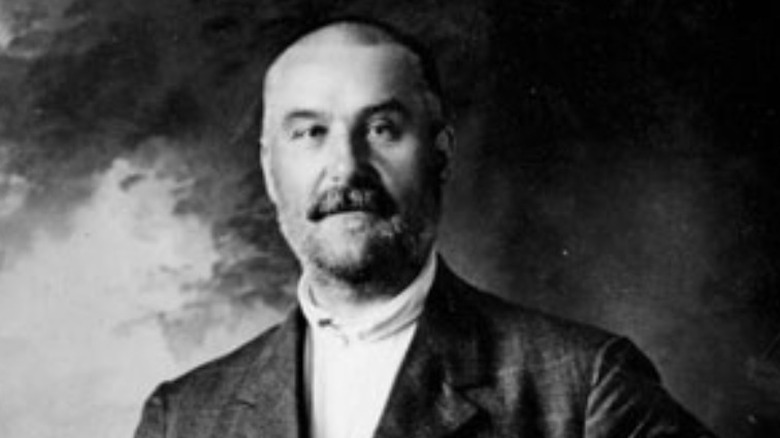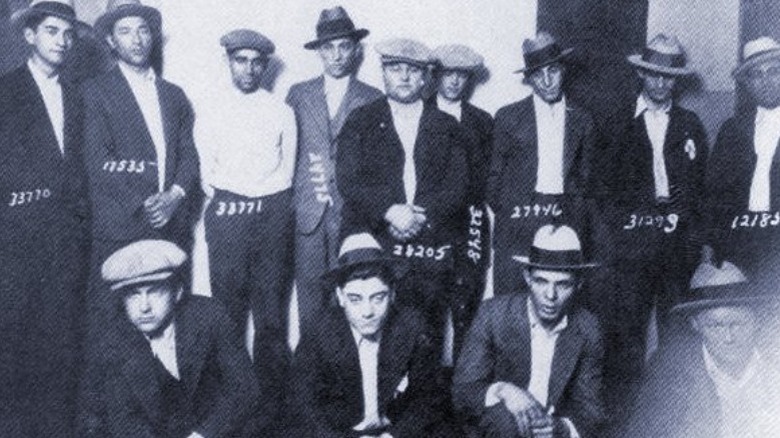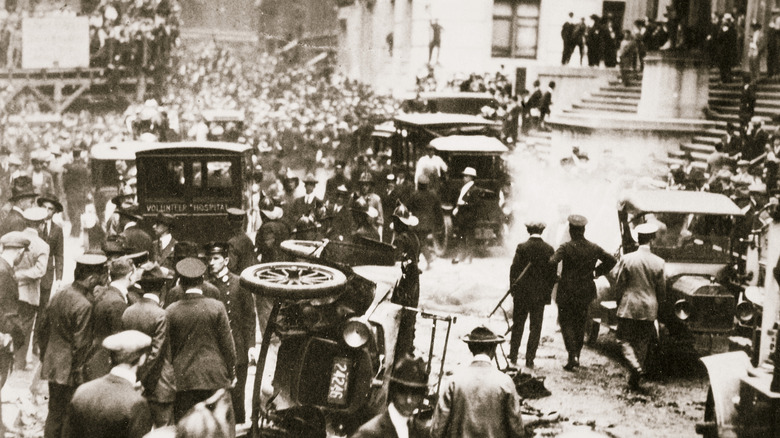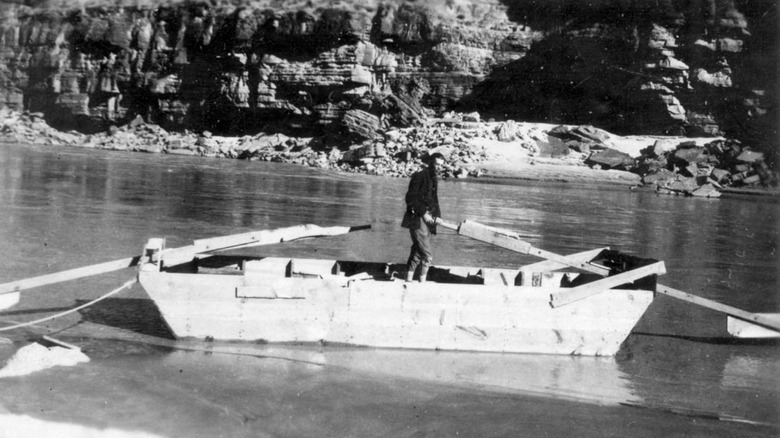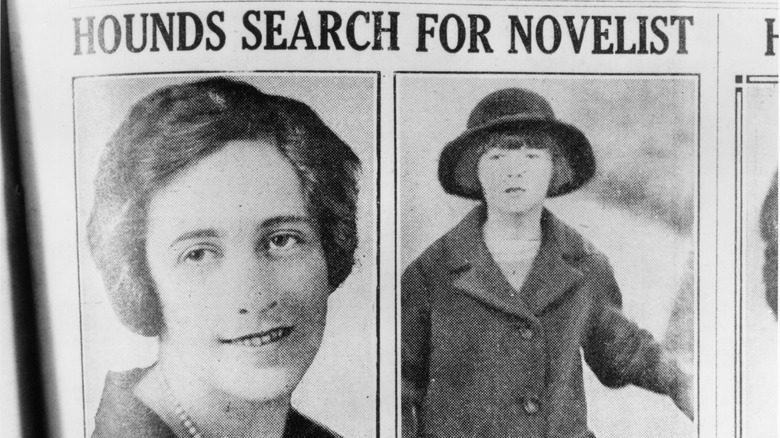Unsolved Mysteries From The Roaring Twenties
Correction 03/09/22: A previous version of this article misstated the name Agatha Christie registered under at a hotel. Sources do not agree which assumed name she used.
For most people, the Roaring 20s conjures up images of flapper dresses, sparkles, and bootleggers wearing fedoras. But the 1920s had a darker side. Throughout the decade, there were murders, explosions, kidnappings, and disappearances, many of which were never solved.
There are many reasons why mysteries in the 1920s may have remained unsolved. It was significantly easier to leave town and disappear after committing a crime, and police didn't have as many resources then as they do now. Some mysteries may have even been deliberately left that way simply because they could be.
Even 100 years later, many of these mysteries remain, well, mysterious, since any possibility of solving them faded away decades ago. But some of the strangest mysteries from the Roaring Twenties held their grip on people from the moment they arose. And while most will probably remain unsolved forever, it's worth taking a look back to see some of the most mysterious events of the Roaring Twenties.
What really happened to Virginia Rappe?
The death of Virginia Rappe and the subsequent trial of actor Roscoe "Fatty" Arbuckle was one of the biggest scandals of the 1920s. And although Arbuckle was found not guilty, it's still unclear exactly what led to Rappe's death. According to Smithsonian Magazine, Rappe and Arbuckle were at a party together at the St. Francis Hotel in San Francisco on September 5, 1921. Arbuckle claimed that after having a few drinks with Rappe, she became "hysterical," and he soon found her vomiting in the bathroom. And when her condition didn't improve for three days, she was finally taken to the hospital. There, doctors discovered that she had a ruptured bladder and peritonitis, which led to her death on September 9th.
At the hospital, Rappe's friend Bambina Maude Delmont claimed that Arbuckle had raped Rappe and caused her death, writes All That's Interesting. But the BBC also notes that before being taken to the hospital, Rappe also claimed "He did this to me." As a result, both Rappe and Arbuckle were disparaged in the papers, which wrote either about Arbuckle's weight causing the ruptured bladder during the alleged rape or blamed Rappe's potential venereal diseases.
According to Urology Case Reports, a ruptured bladder most commonly occurs due to abdominal trauma but can occur if there's chronic inflammation. And while it's suspected that Rappe suffered from cystitis, which may have led to the ruptured bladder, no one will ever know exactly what happened to Virginia Rappe.
How did Thomas H. Ince really die?
Thomas H. Ince was one of the most influential figures in the silent film industry during the beginning of the 20th century, but the circumstances of his death remain unknown to this day, with some even claiming that newspaper mogul William Randolph Hearst was responsible.
On November 16, 1924, Ince boarded The Oneida, Hearst's yacht, for a weekend excursion for Ince's 42nd birthday, according to The Vintage News, in addition to finalizing negotiations over Hearst having access to Ince's film studio. There were a number of other celebrities on the yacht, including Charlie Chaplin, Marion Davies, and Louella Parsons. A dinner was held for Ince's birthday, but Ince allegedly left the dinner early due to stomach cramps. When the cramps worsened, Ince left the yacht and traveled back to Los Angeles with his family. Three days later, on November 19th, Ince was dead, and the doctor put down the cause of death as "heart failure."
But according to the New England Historical Society, soon rumors spread that Ince had been shot on Hearst's yacht after Hearst caught Chaplin and Davies together and hit Ince by mistake in an attempt to shoot Chaplin. And while it's unclear exactly what led to Ince's death, there's evidence that "Hearst tried to silence Ince's wife with a trust fund and Louella Parsons with a lifetime job." But since Ince's body ended up being cremated incredibly quickly, it's impossible to confirm what actually happened.
Who kidnapped Casper Holstein?
Casper Holstein was one of the richest mobsters in New York City during the 1920s, but it's possible that his wealth, or even his philanthropy towards the Black community, made him a target for one of the unsolved kidnappings of the 1920s. After working on Wall Street and studying the illegal lotteries played in New York City, Casper Holstein started his own lottery, known as Bolito, and by the mid-1920s was earning more than $2 million, according to Blackpast.
But then in September 1928, Holstein was kidnapped by five white men who, according to The New York Times, demanded a ransom of $50,000. Holstein ended up being released after three days, but he repeatedly insisted that the ransom wasn't paid. And The St. Thomas Source writes that after being released Holstein refused to identify his kidnappers, even when it appeared as though the police had caught them.
As a result, nobody was arrested in connection with the kidnapping and no one knows exactly what happened. Face2Face Africa also writes that Holstein told reporters that he could in fact identify the kidnappers, "but [he] kept quiet due to business reasons." However, one of the main rumors that circulated claimed that another mobster, Dutch Schultz, set up the kidnapping in order to take over the gambling scene in Harlem. But at the end of the day, no one but Holstein knows exactly what happened over those three days of being taken hostage.
Who murdered Pancho Villa?
Francisco "Pancho" Villa was a key figure of the Mexican Revolution, but by 1920, he'd largely retreated out of politics and guerrilla warfare. According to ThoughtCo, after the assassination of Venustiano Carranza in 1920 by agents of Alvaro Obregón, Villa negotiated a retirement that required him to "stay out of national politics." Villa retired to his 163,000 acre hacienda at Canutillo and rarely left over the next three years. And whenever he did, 50 armed bodyguards came with him, "all of whom were fanatically loyal." But then in July 1923, Villa set off to the town of Parral with only a few of the armed bodyguards he typically traveled with. There, he attended the baptism of and was named godfather to the child of one of his men.
On July 20th, Villa was driving back to Canutillo, but as he drove down a street in Parral, he was assassinated almost instantly as someone shot at him from a house they'd been waiting in for almost three months. El Paso Times reported that the assassins were "deserters from Villa's personal bodyguard," but is that really all they were?
The assassins never ended up being caught, and it was clear that the killing was well organized, especially since "telegraph lines out of Parral had been cut." Although Jesús Salas Barraza soon claimed responsibility for the assassination, this allowed higher officials to evade responsibility, even though the plot likely went all the way up to President Obregón.
Who sabotaged B. H. DeLay's plane?
Before B. H. DeLay was an aerial stuntman, he was a racecar driver. But before long, he'd taken his daredevil skills to the skies and created his own company to perform aerial stunts for motion pictures, according to "Aviators in Early Hollywood." DeLay was no stranger to danger, and during his racing days he'd already experienced broken ribs, arms, and collarbones. But then, in 1923, DeLay's luck seemed to run out.
According to FAM People, on July 4, 1923, DeLay was performing for a crowd at Ocean Park with R.I. Short, President of Essandee corporation, as his passenger. The performance seemed to be going fine but then in the middle of a loop-the-loop the wings of his plane folded back, causing the plane to crash down nose-first. The plane soon burst into flames and although DeLay and Short were pulled out of the wreck, neither survived the crash.
Upon further inspection, it was found that the pins in the airplane's wings were 3/8 of an inch, rather than the standard 1/2 or 3/4 of an inch. This meant that the wings were tampered with and that the crash was the result of sabotage. To this day no one knows who was responsible for DeLay's murder. However, just a few days before the crash, someone reportedly shot at DeLay in Clover Field, so the sabotaged plane was clearly just another attempt to finish the job.
Who blew up Peter Verigin?
Although Peter Vasilevich Verigin didn't arrive in Canada with the 7,500 Doukhobors that immigrated in 1899, he was seen as a leader of the Doukhobor community once he joined them after being released from exile. According to the Dictionary of Canadian Biography, upon arriving in Canada in 1902, Verigin settled near the existing Doukhobor communities and created a village named Veregin in Saskatchewan. Taking up the role as spiritual leader, Verigin also encouraged his followers to register for their 2,700 homesteads, "but to hold the land collectively."
But not everyone was pleased with Verigin. Minister of the Interior Frank Oliver, sought to undo the Doukhobor's collective ownership in an attempt to make more land available. Those who saw their sons sent off to World War I while the Doukhobors avoided conscription with their pacifism resented the community. And among the Doukhobors themselves, there were at least three dissident movements, ranging from Independents, who encouraged private accumulation, to the Sons of Freedom, who feared an "abandonment of true Doukhobor principles," according to Canada's History.
Verigin's life was cut short on October 29, 1924, when he was killed by a train explosion on the Kettle Valley Line on the Canadian Pacific Railway in British Columbia. Eight others were also killed in the explosion. But to this day, no one knows if the explosion was a tragic accident or if it was a deliberate assassination. And according to Canadian Mysteries, no one ever ended up being charged.
The unsolved Milaflores massacre
During the 1920s, the Purple Gang held a firm grip on the bootlegging industry in Detroit. But their legacy came from more than just bootlegging. During their reign, the Purple Gang is thought to have been responsible for hundreds of gang-related murders, rivaled only by Murder Inc. and Al Capone's crew. But some of their killings, like the Milaflores Massacre, remain unsolved to this day.
According to The Purple Gang Blog, the Milaflores Massacre is thought to have originated with the murder of Johnny Reid in 1921. Reid was one of the biggest distributors for the Purple Gang, and so the gang decided to retaliate. However, it's unclear why the retaliation would've taken another six years to plan.
But on March 28, 1927, it's believed the Purple Gang lured Frank Wright and two other men whom they thought were responsible for Reid's murder into the Milaflores Apartments in Detroit. There, the three men were allegedly mowed down by the Purple Gang in what became known as the "the first machine-gun slaying in state history," according to The Gangster Report. The apartment where the murder took place was leased by Eddie Fletcher and Abe Axler, both members of the Purple Gang. But in the end, nobody ended up being charged with the crime.
Who was responsible for the Wall Street Bombing of 1920?
Although Italian anarchists were blamed for the Wall Street bombing of 1920, no one was ever convicted for the bombing. One would think that an attack on the burgeoning financial capital of the United States would warrant an intense investigation, but within 20 years even the FBI had given up.
On the morning of September 16, 1920, witnesses claimed that they saw a wagon park outside J.P. Morgan & Company bank and the driver left the wagon unattended, according to "Terrorism on American Soil." And then, one minute after noon, a massive explosion rocked the area, shattering windows across a half-mile radius, writes The Street. Up to 300 people were injured and at least 40 people were killed, largely due to the 500 pounds of shrapnel that was packed along with the explosive. But the next day, the New York Stock Exchange building was back up and running and sheets were used to cover up the horrors left over from the day before.
The "American Anarchist Fighters" were blamed due to the leaflets found near the explosion site, according to the FBI, but although many anarchists were picked up during the Palmer Raids, no one was ever charged in connection with the 1920 Wall Street Bombing. Damn Interesting also writes that after the bombing, speaking out against Wall Street was seen as being anti-patriotic, so was it all just a ploy to create compassion for capitalism?
Who's responsible for the Lava Lake murders?
Known as the Lava Lake murders, the murders of Ed Nichols, Roy Wilson, and Dewey Morris was one of the most gruesome murders Oregon witnessed during the 1920s. And although police had a main suspect, insufficient evidence meant that the crime remains officially unsolved to this day. Nichols, Wilson, and Morris were found by family members in April 1924, near their isolated cabin in Little Lava Lake, where they lived and worked as trappers during the winter months, according to The Source Weekly. The last that anyone had seen or heard from the men was around January 15th, so by April the families became worried and ventured out to the cabin.
But Mental Floss writes that the cabin was abandoned and it looked as though no one had been in the cabin for at least two months. And in the nearby storage shed, they also found a bloodstained hammer. Before long, they discovered the bodies of the three men in what looked like a hole in the ice that had "been cut in the ice and had refrozen." All three had gunshot wounds, likely from a shotgun blast.
After hearing that a former Elk Lake Lodge employee named Charles Kimzey had threatened one of the trappers, a $1,000 reward was offered for Kimzey's capture. But even with the reward, it took almost many years to find Kimzey, and in the end, no one was able to prove that Kimzey was responsible.
Who robbed Hartselle Bank?
Also known as "one of the most brazen bank robberies" in the history of Alabama, the perpetrators of the 1926 robbery of the Bank of Hartselle were never caught, at least in regards to that particular robbery. Some of the suspects ended up being charged and convicted for other crimes later down the line, but the robbery of Hartselle Bank remains an unsolved mystery.
According to the Hartselle Chamber of Commerce, the Great Hartselle Bank Robbery occurred in the early hours of March 15, 1926, when between 5 to 15 men came into town shortly after midnight to loot the bank. Telephone cables were cut, leaving the town of Hartselle unable to contact the outside world, and with "eight blasts of nitroglycerin," the safe in the Bank of Hartselle was blown open. Roughly $15,000 in cash, gold, and silver was taken, worth approximately $230,000 in 2021. But according to the Hartselle Enquirer, since the bank was insured, they suffered no losses. If anything, it seemed as though the bank "enjoyed more business and depositors than it had before the robbery."
Out of the 15 men believed to have been involved in the robbery, six were investigated but no arrests were ever made, and they were all eventually released. And while some of those six were later caught on other charges, no one ever figured out exactly who was responsible for the 1926 robbery of the Bank of Hartselle.
What happened to Glen and Bessie Hyde?
When Glen and Bessie Hyde set out for their extended honeymoon in 1928, nobody knew that they'd never be heard from again. According to Inside the Simulation, Glen and Bessie Hyde had set out for a trip down the rapids in the Colorado and Green rivers and were halfway through their travels when they left the Kolb family on November 19, 1928. But when nobody heard from the Hydes after a few weeks, a search party was organized.
Adventure Journal writes that the Hydes' boat was found on December 20, but there was no indication that the boat had been overturned, and all of their supplies and food were still strapped into the boat. Meanwhile, it appeared as though the couple had simply vanished into thin air. It was assumed that the two of them had drowned, but no bodies ever turned up either.
Then, almost 50 years later, an old woman named Georgie Clark claimed that she was the real Bessie Hyde, and that she was responsible for killing Glen. History Collection writes that Clark later denied everything when asked again, but when she died, some of her friends decided to look in her house for clues. There, they found a birth certificate with the name Bessie DeRoss, a pistol, and a marriage certificate of Bessie and Glen Hyde. And yet none of Clark's younger photos looked anything like Bessie, leaving the story even stranger than when it started.
Where did Agatha Christie go?
It only seems fair that one of the most acclaimed mystery writers would be involved in a mind-boggling mystery of her own. On December 3, 1926, mystery writer Agatha Christie left her home in Sunningdale, Berkshire after arguing with her husband, Archibald Christie. All That's Interesting writes that Christie wrote a note for her secretary saying that she wouldn't be coming home that night, and left her house with a briefcase, taking the family's car.
What happened over the next 11 days is something that only Christie knows, reminiscent of a "Breaking Bad" fugue state. According to Novel Suspects, Archie reported Christie missing the next day, and soon her car was found abandoned with her clothes and driver's license left inside. Police immediately began to question Archie, who was the last person to see Christie alive, and tried to pressure him into confessing while they continued to search for her.
But then, all of a sudden, Christie was spotted alive and well in a Yorkshire spa, which is where her brother-in-law told the police she might be. But for some reason, she was registered under an assumed name — some report it was Nancy Neele, or Neale, or possibly Theresa Neale. And upon being found, Christie claimed that she had amnesia and was suffering from "the most complete loss of memory," a claim she maintained even in her own memoir. Was it a fugue state? Or was Christie just tired of her cheating husband? This is one mystery that Agatha Christie took to her grave.

